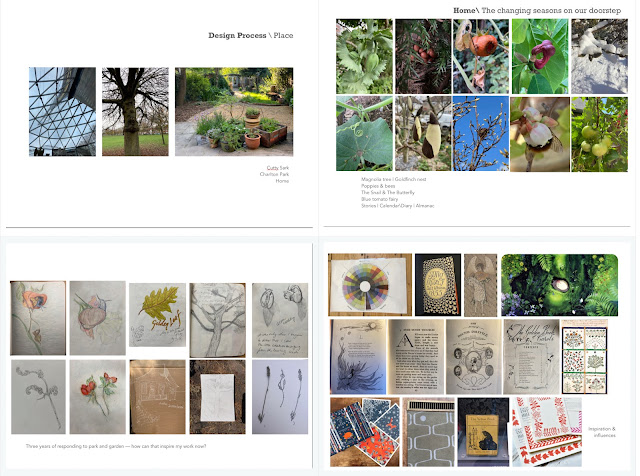Week Nine : Design Process \ Discover
Design Process : Identify
Briefed to identify three places to respond to over the next three weeks, I explored the Cutty Sark; Charlton Park and my garden at home. In my practice for three years now I have consciously responded to the changing seasons, especially as they are reflected in the signs of nature. In the process of my preparation for this project, I’ve been able to draw on the extensive research from that time as well as collating sketches, studies and photographs. This has led me to identify my garden and local park as the place to inspire my design process; and more specifically the elements I can see of the changing seasons in trees plants wildlife and weather.
I find it helpful to gather the disparate pieces of work photographic research and inspiration into keynote presentation. This way I see themes begin to emerge and start to order my thoughts to give focus for the next stage in my process.
:
Having experimented with adding block colour background to a black and white illustration using the paintbrush and paint bucket tools in Photoshop, I wanted to explore creating my own more textured background. I scanned in some existing fragments I found in my archived work and found that the colour translates well. I wanted to create a larger piece that would work full bleed behind an A4 image. Using wallpaper lining paper dipped in watered-down acrylic, I photographed the pages while wet, which adds an additional layer of reflection; and scanned the dried paper. I am interested now to apply these as backgrounds in photoshop. All three results are very different and I’m excited that the intensity of hue survives whether scanned or photographed.
I’m really interested to explore the potential of physical, traditional media when combined with digital layering and refinement.
Site visit | Cutty Sark
:
Cutty Sark is a gift for storytellers ― visually and historically it’s alive with tales at every turn. I sought patterns and faces; and particularly focused on the ship’s figurehead Nannie Dee. She’s named for a Robert Burns poem, Tam O’Shanter, and I have a story that I considered illustrating for this project; telling Nannie’s side of the events that night. I also loved to discover that there are very few surviving original China Tea chests, because the lead was melted down to use in printing.
In the end I decided not to pursue this strand in my project, as I am interested in communication that is more universal, less bound to one identifiable location that only has significance for certain audiences.
:
This week’s discovery has been a real contrast to the academic research for the Courtauld review. I’ve enjoyed the eclectic mix of gathering titbits found online; physically collecting inspiration from the natural world; experimenting with different media and subsequent ways of capturing the results; and drawing on materials I have collected and kept for reference and inspiration in the past.
I am looking forward to deeper digital experimentation next week.








Comments
Post a Comment